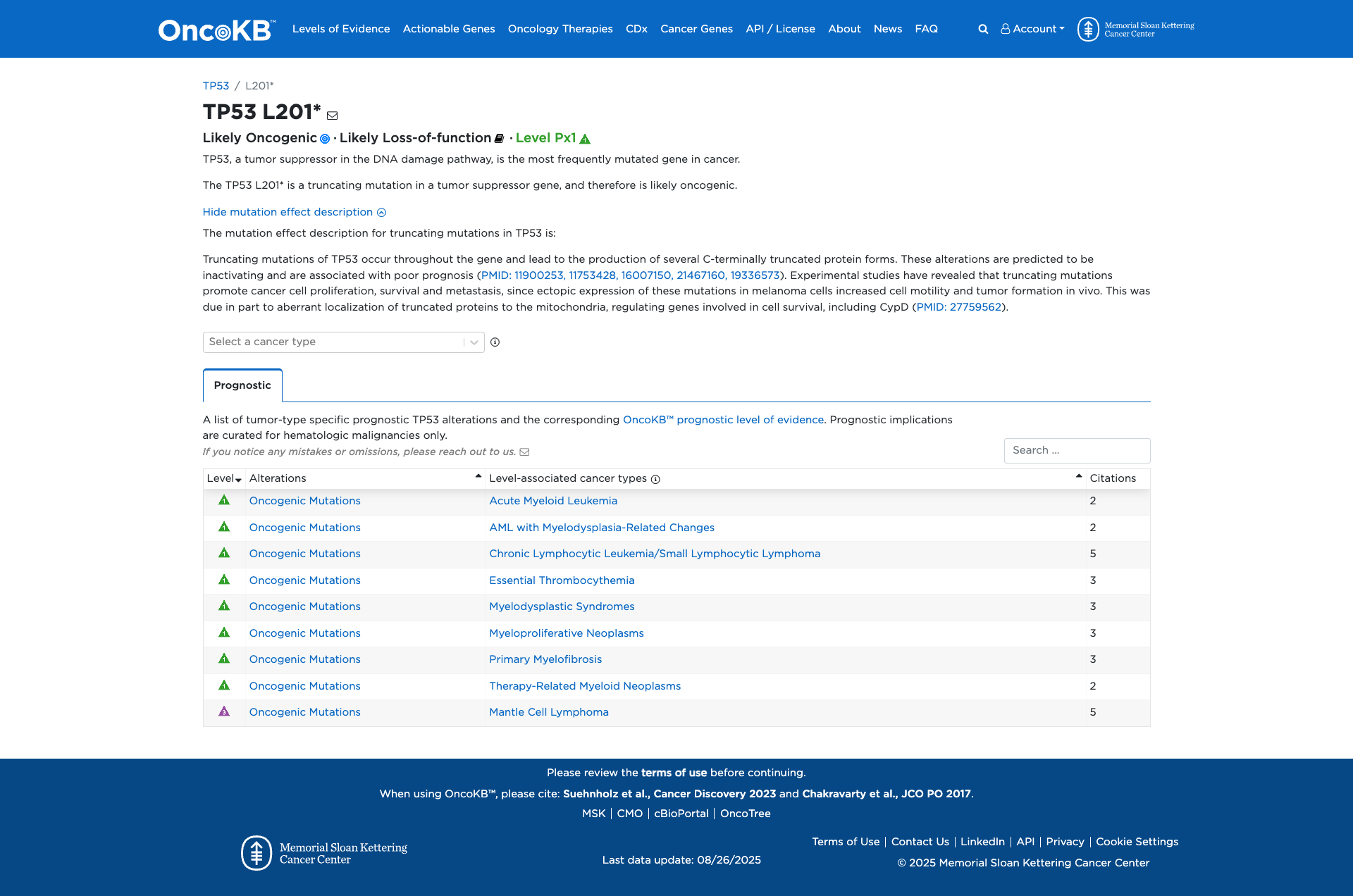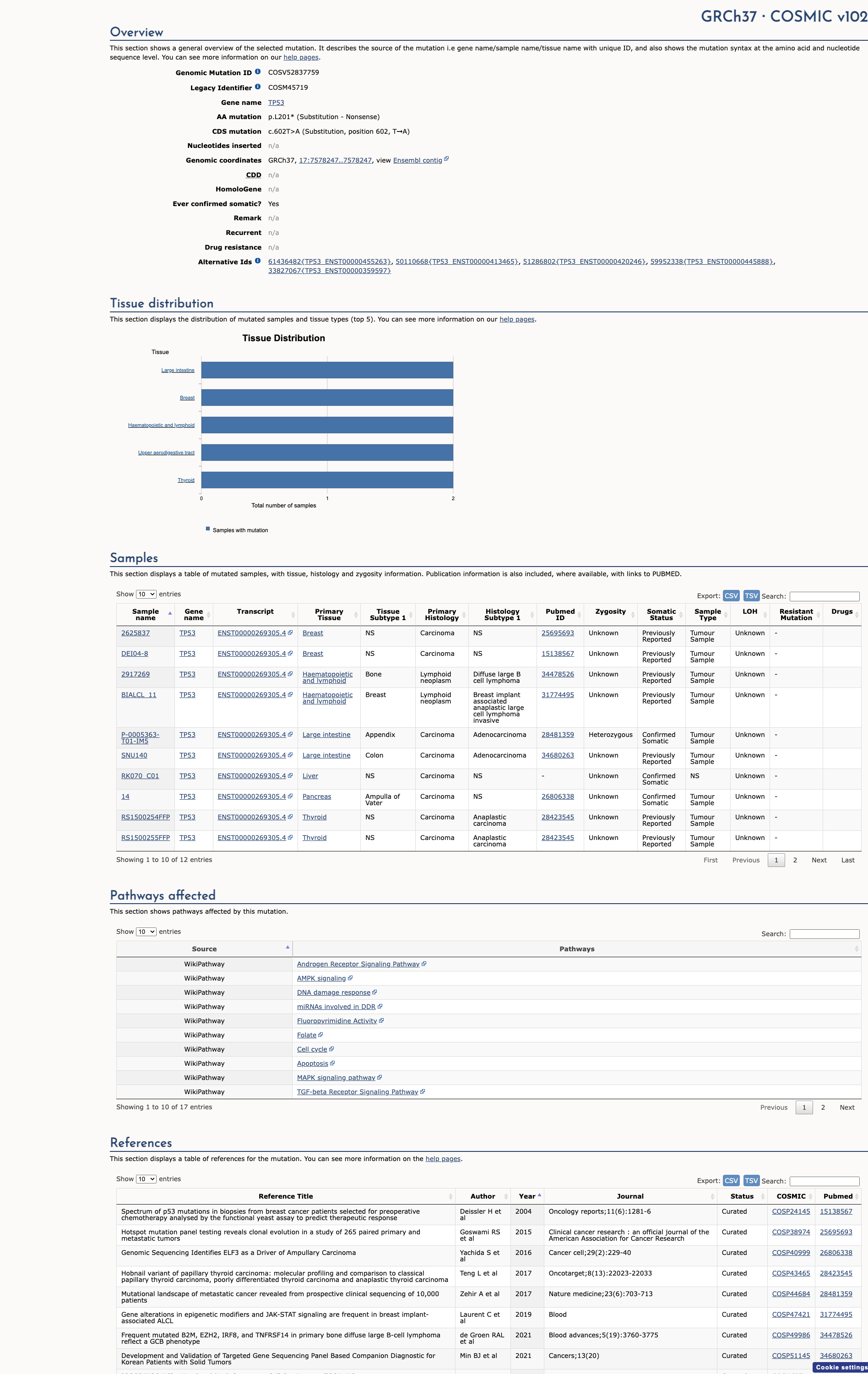TP53 c.602T>A, p.Leu201Ter
NM_000546.5:c.602T>A
COSMIC ID: COSM3742472, COSM45719
Pathogenic
This nonsense variant introduces a premature stop upstream of the NMD threshold, meeting PVS1_Very Strong, and is absent from population databases, meeting PM2_Supporting. No additional criteria apply. These findings support a classification of Likely Pathogenic.
ACMG/AMP Criteria Applied
PVS1
PM2
Genetic Information
Gene & Transcript Details
Gene
TP53
Transcript
NM_000546.6
MANE Select
Total Exons
11
Strand
Reverse (−)
Reference Sequence
NC_000017.10
Alternative Transcripts
| ID | Status | Details |
|---|---|---|
| NM_000546.5 | RefSeq Select | 11 exons | Reverse |
| NM_000546.3 | Alternative | 11 exons | Reverse |
| NM_000546.4 | Alternative | 11 exons | Reverse |
| NM_000546.2 | Alternative | 11 exons | Reverse |
Variant Details
HGVS Notation
NM_000546.5:c.602T>A
Protein Change
L201*
Location
Exon 6
(Exon 6 of 11)
5'Exon Structure (11 total)3'
Functional Consequence
Loss of Function
Related Variants
Alternate Identifiers
COSM3742472, COSM45719
Variant interpretation based on transcript NM_000546.6
Genome Browser
Loading genome browser...
HGVS InputNM_000546:c.602T>A
Active Tracks
ConservationRefSeqClinVargnomAD
Navigation tips: Use mouse to drag and zoom. Click on features for details.
Clinical Data
Population Frequency
Global Frequency
0.0 in 100,000
Extremely Rare
Global: 0.0%
0%
0.05%
0.1%
1%
5%
10%+
ACMG Criteria Applied
PM2
This variant is not present in gnomAD (PM2 criteria applies).
Classification
Unknown
Publications (0)
No publication details.
Clinical Statement
Functional Impact
Functional Domain
Hotspot Status
Not a hotspot
Domain Summary
This variant is not located in a mutational hotspot or critical domain (0 mutations).
Related Variants in This Domain
Functional Summary
The TP53 L201* variant is a truncating mutation in the tumor suppressor gene TP53. Functional evidence indicates that truncating mutations in TP53 lead to the production of C-terminally truncated protein forms, which are predicted to be inactivating. Experimental studies have shown that these mutations promote cancer cell proliferation, survival, and metastasis, partly due to aberrant localization of truncated proteins to the mitochondria, affecting genes involved in cell survival. Therefore, the TP53 L201* variant is functionally characterized as likely damaging.
Database Previews
OncoKB

JAX-CKB

Click on previews to view full database entries. External databases may require institutional access.
Computational Analysis
Pathogenicity Predictions
Predictor Consensus
Mixed/VUS
PP3 Applied
No
Additional Predictors
Benign:
CADD: 5.78
Neutral: Show all
VCEP Guidelines
Applied ACMG/AMP Criteria (VCEP Specific) VCEP Guidelines
PVS1
PVS1 (Very Strong)
According to VCEP guidelines, the rule for PVS1 is: "Nonsense or frameshift variants predicted to result in nonsense-mediated decay (PTC upstream of p.Lys351) => PVS1 applies at Very Strong strength." The evidence for this variant shows a nonsense change (L201*) upstream of p.Lys351, predicted to undergo NMD. Therefore, this criterion is applied at Very Strong strength because the variant meets the VCEP rule for LOF via NMD.
PS1
PS1 (Not Applied) Strength Modified
According to VCEP guidelines, the rule for PS1 is: "Can be applied to variants asserted as Pathogenic following the TP53 VCEP’s specifications." The evidence for this variant shows a novel nonsense change with no identical amino acid change previously classified as Pathogenic. Therefore, this criterion is not applied.
PS2
PS2 (Not Applied) Strength Modified
According to VCEP guidelines, the rule for PS2 is based on de novo occurrence points. The evidence for this variant shows no de novo data. Therefore, this criterion is not applied.
PS3
PS3 (Not Applied) Strength Modified
According to VCEP guidelines, the caveat is: "PS3 should not be applied at any strength if PVS1 is applied at full strength." The evidence shows PVS1 at Very Strong applied. Therefore, PS3 is not applied.
PS4
PS4 (Not Applied) Strength Modified
According to VCEP guidelines, the rule for PS4 is based on proband counting. The evidence for this variant shows no case counts provided. Therefore, this criterion is not applied.
PM1
PM1 (Not Applied) Strength Modified
According to VCEP guidelines, the rule for PM1 is: "Missense variants within specified TP53 hotspot codons." The evidence for this variant is a nonsense change, not a missense variant. Therefore, this criterion is not applied.
PM2
PM2 (Supporting) Strength Modified
According to VCEP guidelines, the rule for PM2 is: "Variant should have allele frequency <0.00003 in gnomAD => PM2 at Supporting strength." The evidence for this variant shows absence from gnomAD. Therefore, this criterion is applied at Supporting strength because the variant meets the allele frequency threshold.
PM3
PM3 (Not Applied) Strength Modified
According to standard ACMG guidelines, PM3 applies to recessive disorders with trans variants. The evidence for this variant shows no trans data in a recessive context. Therefore, this criterion is not applied.
PM4
PM4 (Not Applied) Strength Modified
According to standard ACMG guidelines, PM4 applies to protein length changes in non-LOF genes. The evidence for this variant shows LOF mechanism in TP53. Therefore, this criterion is not applied.
PM5
PM5 (Not Applied) Strength Modified
According to VCEP guidelines, PM5 applies to missense variants at residues with known pathogenic missense changes. The evidence for this variant is a nonsense change. Therefore, this criterion is not applied.
PM6
PM6 (Not Applied) Strength Modified
According to standard ACMG guidelines, PM6 applies to assumed de novo without confirmation. The evidence for this variant shows no de novo data. Therefore, this criterion is not applied.
PP1
PP1 (Not Applied) Strength Modified
According to VCEP guidelines, PP1 requires cosegregation in families. The evidence for this variant shows no segregation data. Therefore, this criterion is not applied.
PP2
PP2 (Not Applied) Strength Modified
According to standard ACMG guidelines, PP2 applies to genes with low rate of benign missense variation. The evidence for this variant is a nonsense change. Therefore, this criterion is not applied.
PP3
PP3 (Not Applied) Strength Modified
According to VCEP guidelines, the caveat is: "PP3 should not be used in combination with PVS1." The evidence shows PVS1 at Very Strong applied. Therefore, PP3 is not applied.
PP4
PP4 (Not Applied) Strength Modified
According to standard ACMG guidelines, PP4 applies to highly specific phenotype. The evidence for this variant shows no phenotype data. Therefore, this criterion is not applied.
PP5
PP5 (Not Applied) Strength Modified
According to standard ACMG guidelines, PP5 applies to reputable source assertions. The evidence for this variant shows no ClinVar entry. Therefore, this criterion is not applied.
BA1
BA1 (Not Applied) Strength Modified
According to VCEP guidelines, BA1 applies to allele frequency ≥0.001 in gnomAD. The evidence for this variant shows absence from gnomAD. Therefore, this criterion is not applied.
BS1
BS1 (Not Applied) Strength Modified
According to VCEP guidelines, BS1 applies to allele frequency ≥0.0003 and <0.001. The evidence for this variant shows absence from gnomAD. Therefore, this criterion is not applied.
BS2
BS2 (Not Applied) Strength Modified
According to VCEP guidelines, BS2 applies to unaffected older female carriers. The evidence for this variant shows no such data. Therefore, this criterion is not applied.
BS3
BS3 (Not Applied) Strength Modified
According to VCEP guidelines, BS3 applies to functional data showing no LOF. The evidence for this variant shows LOF mechanism. Therefore, this criterion is not applied.
BS4
BS4 (Not Applied) Strength Modified
According to VCEP guidelines, BS4 applies to lack of segregation in affected members. The evidence for this variant shows no segregation data. Therefore, this criterion is not applied.
BP1
BP1 (Not Applied) Strength Modified
According to standard ACMG guidelines, BP1 applies to missense in genes where LOF is the mechanism. The evidence for this variant is LOF. Therefore, this criterion is not applied.
BP2
BP2 (Not Applied) Strength Modified
According to standard ACMG guidelines, BP2 applies to observed in trans with pathogenic variant. The evidence for this variant shows no such data. Therefore, this criterion is not applied.
BP3
BP3 (Not Applied) Strength Modified
According to standard ACMG guidelines, BP3 applies to in-frame deletions/repeat expansions. The evidence for this variant is a nonsense change. Therefore, this criterion is not applied.
BP4
BP4 (Not Applied) Strength Modified
According to VCEP guidelines, BP4 applies to in silico scores below thresholds. The evidence for this variant shows mixed computational results and PVS1 at full strength. Therefore, BP4 is not applied.
BP5
BP5 (Not Applied) Strength Modified
According to standard ACMG guidelines, BP5 applies when alternate cause is present. The evidence for this variant shows no alternate cause. Therefore, this criterion is not applied.
BP6
BP6 (Not Applied) Strength Modified
According to standard ACMG guidelines, BP6 applies to reputable source benign assertions. The evidence for this variant shows no benign assertions. Therefore, this criterion is not applied.
BP7
BP7 (Not Applied) Strength Modified
According to VCEP guidelines, BP7 applies to synonymous or intronic variants with no splicing impact. The evidence for this variant is nonsynonymous (nonsense). Therefore, this criterion is not applied.

